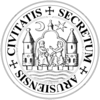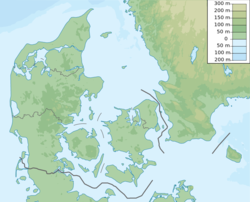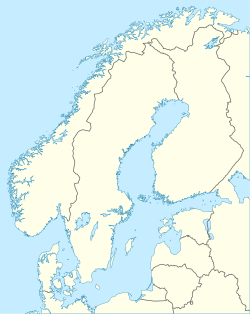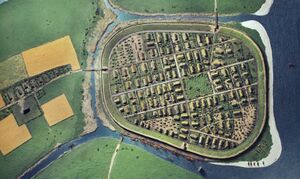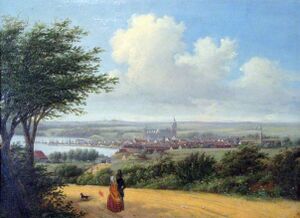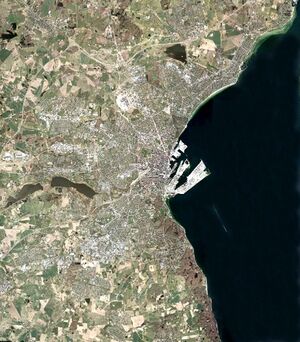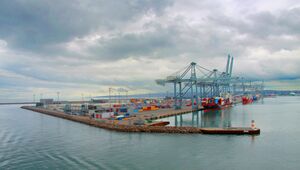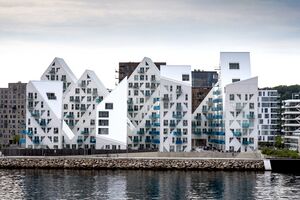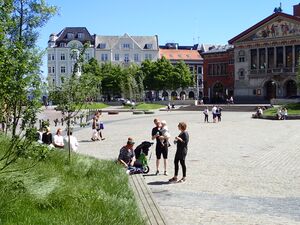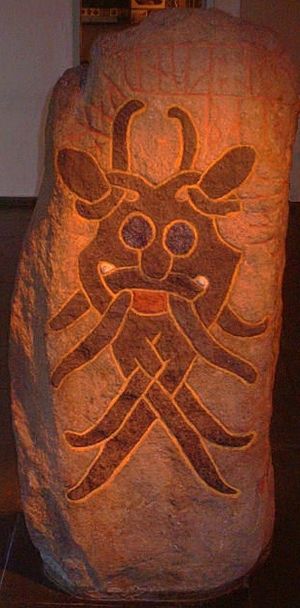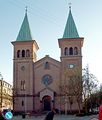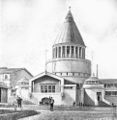آرهوس
Aarhus | |
|---|---|
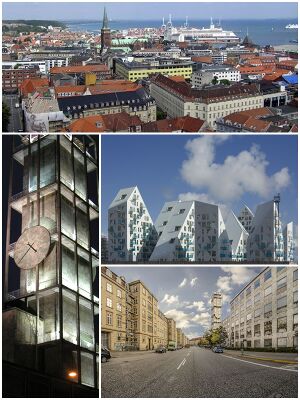 | |
| الكنية: Smilets by (City of smiles) | |
| الإحداثيات: 56°09′N 10°13′E / 56.150°N 10.217°E | |
| Country | Denmark |
| Region | Central Denmark Region (Midtjylland) |
| Municipality | Aarhus |
| Established | 8th century |
| City Status | 15th century |
| السمِيْ | Aarhus River mouth |
| الحكومة | |
| • النوع | Magistrate |
| • Mayor | Jacob Bundsgaard (S) |
| المساحة | |
| • الحضر | 98٫4 كم² (38�0 ميل²) |
| • Municipal | 468 كم² (181 ميل²) |
| أعلى منسوب | 105 m (344 ft) |
| أوطى منسوب | 0 m (0 ft) |
| التعداد (1 January 2021)[2] | |
| • الترتيب | Denmark: 2nd |
| • Urban | 282٬910 |
| • الكثافة الحضرية | 2٬854/km2 (7٬390/sq mi) |
| • Municipal | 352٬751 |
| • كثافة Municipal | 745/km2 (1٬930/sq mi) |
| صفة المواطن | Aarhusianer |
| منطقة التوقيت | UTC+1 (CET) |
| • الصيف (التوقيت الصيفي) | UTC+2 (CEST) |
| Postal code | 8000, 8200, 8210, 8220, 8230 |
| مفتاح الهاتف | (+45) 8 |
| الموقع الإلكتروني | Official website |
آرْهوس ( Aarhus أو Århus ؛ (/ˈɔːrhuːs/, US also /ˈɑːr-/,[3][4][5][6] الدنماركية: [ˈɒːˌhuˀs] (![]() استمع); officially spelled Århus from 1948 until 1 January 2011)[7][note 1] هي ثاني أكبر مدن الدنمارك. وهي ميناء بحري على ساحل يوتلاند الشرقي، في بحر كاتگات، تقع على بعد 187 كم شمال غرب كوبنهاگن. وهي مركز تجاري وصناعي. وعدد سكانها 204,139 نسمة. وفي أرهوس كاتدرائية، بُنيت في القرن الثاني عشر الميلادي، وجامعة أسست عام 1928.
استمع); officially spelled Århus from 1948 until 1 January 2011)[7][note 1] هي ثاني أكبر مدن الدنمارك. وهي ميناء بحري على ساحل يوتلاند الشرقي، في بحر كاتگات، تقع على بعد 187 كم شمال غرب كوبنهاگن. وهي مركز تجاري وصناعي. وعدد سكانها 204,139 نسمة. وفي أرهوس كاتدرائية، بُنيت في القرن الثاني عشر الميلادي، وجامعة أسست عام 1928.
The largest city in Jutland, Aarhus anchors the Central Denmark Region and the statistical region Landsdel Østjylland (LØ) (lit.: Province East Jutland). The LØ is the second most populous statistical region in Denmark with an estimated population of 903,974 (اعتبارا من 1 يناير 2021[تحديث]). Aarhus Municipality defines the greater Aarhus area as itself and 8 adjacent municipalities totalling 952,824 inhabitants (اعتبارا من 1 يناير 2021[تحديث]) which is roughly analogous to the municipal and commercial collaboration Business Region Aarhus.[8][9] The city proper, with an estimated population of 282,910 inhabitants (as of 2021), ranks as the 2nd-largest city in Denmark.
Aarhus dates back to at least the late 8th century and is among the oldest cities in Denmark. It was founded as a harbour settlement at the mouth of the Aarhus River and quickly became a trade hub. The first Christian church was built here around the year 900 and later in the Viking Age the town was fortified with defensive ramparts. The Viking Age was turbulent and violent, also for Aros, as the town was called back then, but in spite of the difficulties, the bishopric of Aarhus grew steadily stronger and more prosperous, building several religious institutions in the town during the early Middle Ages. Trade continued to improve, although it was not until 1441 that Aarhus was granted Market town privileges, and the population of Aarhus remained relatively stable until the 19th century. The 1600s, in particular, was a difficult time for Aarhus as the town suffered from several wars and the plague, and trade was also dampened by the state in favour of the royal seat of Copenhagen. Nevertheless, Aarhus grew to become the second biggest town in Denmark during that time, and in the middle of the 1700s, the once prosperous trade growth returned. The industrial revolution became an inflection point in the 19th century, as industry drove a rapid population growth, outpacing regional rivals, and the first railway line in Jutland was built here in 1862. In 1928, the first university in Jutland was founded in Aarhus and today it is a university city and the largest centre for trade, services, industry, and tourism in Jutland.
Designated as a "Sufficiency" global city by the Globalization and World Cities Research Network,[10] the city's major cultural institutions include Den Gamle By, ARoS Aarhus Kunstmuseum, Moesgård Museum, Kvindemuseet, Musikhuset and Aarhus Theatre. Known as Smilets By (lit. City of Smiles) it is the Danish city with the youngest and fastest growing demographics and home to Scandinavia's largest university, Aarhus University.[2][11] Commercially, the city is the principal container port in the country and major Danish companies are headquartered here such as Vestas, Arla Foods, Salling Group, and Jysk.
Spelling
The spelling "Aarhus" is first found in 1406 and gradually became the norm in the 17th century.[12] With the Danish spelling reform of 1948, "Aa" was changed to "Å". Some Danish cities resisted the change but Aarhus city council opted to change the name.[13] In 2010, the city council voted to change the name back from Århus to Aarhus again with effect from 1 January 2011.
التاريخ
Early history
Founded in the early Viking Age, Aarhus is one of the oldest cities in Denmark, along with Ribe and Hedeby.[14] The original Aros settlement was situated on the northern shores of a fjord by the mouth of the Aarhus River, right where the city center is today. It quickly became a hub for sea-going trade due to its position on intersecting trade routes in the Danish straits and the fertile countryside. The trade, however, was not nearly as prominent as that in Ribe and Hedeby during the Viking Age, and it was primarily linked to Norway as evidenced by archaeological finds. A shipbuilding yard from the Viking Age was uncovered upriver in 2002 by archaeologists. It was located at a place formerly known as Snekkeeng, or Snekke Meadow in English ('Snekke' is a type of longship), east of the Brabrand Lake close to Viby, and it was in use for more than 400 years from the late 700s till around the mid-1200s.[15]
Archaeological evidence indicate Aarhus was a town as early as the last quarter of the 8th century.[16][17] Discoveries after a 2003 archaeological dig, includes half-buried longhouses, firepits, glass pearls and a road dated to the late 700s.[18] Several excavations in the inner city since the 1960s, has revealed wells, streets, homes and workshops, and inside the buildings and adjoining archaeological layers, everyday utensils like combs, jewellery and basic multi-purpose tools from approximately the year 900 has been unearthed.[19] The early town was fortified with defensive earthen ramparts in the first part of the 900s, possibly in the year 934 on order from king Gorm the Old. The fortifications were later improved and expanded by his son Harald Bluetooth, encircling the settlement much like the defence structures found at Viking ring fortresses elsewhere.[16] Together with the town's geographical placement, this suggests that Aros became an important military centre in the Viking Age. There are also strong indications of a former royal residence from the same period in Viby, a few kilometres south of the Aarhus city centre.[20][21]
Industrialisation
Following the Napoleonic wars, Denmark lost Norway and was excluded from international trade for some years which caused a recession for Aarhus's trade-based economy that lasted until the 1830s. The economy turned around as the industrial revolution reached the city and factories with steam-driven machinery became more productive.
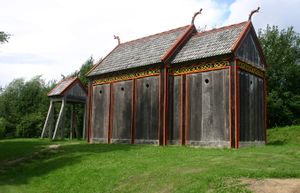
تطورت أورهوس من قرية صغيرة أنشئت في القرن التاسع الميلادي.
قرية ڤايكنگ وما قبلها
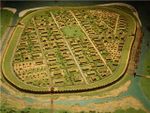
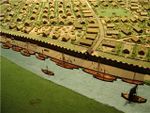
الجغرافيا
Aarhus is located at the Bay of Aarhus facing the Kattegat sea in the east with the peninsulas of Mols and Helgenæs across the bay to the northeast. Mols and Helgenæs are both part of the larger regional peninsula of Djursland. A number of larger cities and towns is within easy reach from Aarhus by road and rail, including Randers (38.5 كيلومتر (23.9 mi) by road north), Grenå (northeast), Horsens (50 كيلومتر (31 mi) south) and Silkeborg (44 كيلومتر (27 mi) east).[22]
المناخ
| شرق يوتلاند | ||||||||||||||||||||||||||||||||||||||||||||||||||||||||||||
|---|---|---|---|---|---|---|---|---|---|---|---|---|---|---|---|---|---|---|---|---|---|---|---|---|---|---|---|---|---|---|---|---|---|---|---|---|---|---|---|---|---|---|---|---|---|---|---|---|---|---|---|---|---|---|---|---|---|---|---|---|
| جدول طقس (التفسير) | ||||||||||||||||||||||||||||||||||||||||||||||||||||||||||||
| ||||||||||||||||||||||||||||||||||||||||||||||||||||||||||||
| ||||||||||||||||||||||||||||||||||||||||||||||||||||||||||||
| بيانات المناخ لـ شرق يوتلاند (1961–1990) | |||||||||||||
|---|---|---|---|---|---|---|---|---|---|---|---|---|---|
| الشهر | ينا | فب | مار | أبر | ماي | يون | يول | أغس | سبت | أكت | نوف | ديس | السنة |
| متوسط القصوى اليومية °س (°ف) | 4.4 (39.9) |
4.5 (40.1) |
8.3 (46.9) |
12.5 (54.5) |
18.7 (65.7) |
20.2 (68.4) |
23.4 (74.1) |
23.1 (73.6) |
19.0 (66.2) |
12.3 (54.1) |
9.7 (49.5) |
6.4 (43.5) |
13.5 (56.3) |
| المتوسط اليومي °س (°ف) | 2.0 (35.6) |
1.9 (35.4) |
4.6 (40.3) |
8.1 (46.6) |
13.8 (56.8) |
16.0 (60.8) |
18.5 (65.3) |
18.2 (64.8) |
14.8 (58.6) |
9.6 (49.3) |
6.7 (44.1) |
3.8 (38.8) |
9.8 (49.7) |
| متوسط الدنيا اليومية °س (°ف) | −0.5 (31.1) |
−0.7 (30.7) |
0.8 (33.4) |
3.7 (38.7) |
8.9 (48.0) |
11.8 (53.2) |
13.5 (56.3) |
13.3 (55.9) |
10.5 (50.9) |
6.9 (44.4) |
3.7 (38.7) |
1.1 (34.0) |
6.1 (43.0) |
| متوسط تساقط الأمطار mm (inches) | 60 (2.4) |
41 (1.6) |
48 (1.9) |
42 (1.7) |
50 (2.0) |
55 (2.2) |
67 (2.6) |
65 (2.6) |
72 (2.8) |
77 (3.0) |
80 (3.1) |
68 (2.7) |
722 (28.4) |
| Average rainy days (≥ 1mm) | 11 | 8 | 7 | 9 | 9 | 9 | 10 | 10 | 11 | 11 | 13 | 12 | 120 |
| Mean monthly ساعات سطوع الشمس | 41 | 75 | 141 | 207 | 254 | 251 | 243 | 239 | 165 | 101 | 65 | 45 | 1٬827 |
| Source: "Danish Meteorological Institute". | |||||||||||||
السكان
| Main immigrant groups, 2017[24] | |
| Nationality | التعداد |
|---|---|
| 5,030 | |
| 4,554 | |
| 4,370 | |
| 3,688 | |
| 2,577 | |
| 2,551 | |
| 2,261 | |
| 2,235 | |
| 2,092 | |
| 1,983 | |
الاقتصاد
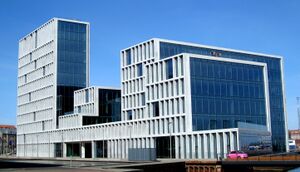
The economy of Aarhus is predominantly knowledge- and service-based, strongly influenced by the University of Aarhus and the large healthcare industry. The service sector dominates the economy and is growing as the city transitions away from manufacturing. Trade and transportation remain important sectors, benefiting from the large port and central position on the rail network. Manufacturing has been in slow but steady decline since the 1960s while agriculture has long been a marginal sector within the municipality.[25] The municipality is home to 175,000 jobs with some 100,000 in the private sector and the rest split between state, region and municipality.[26] The region is a major agricultural producer, with many large farms in the outlying districts.[27] People commute to Aarhus from as far away as Randers, Silkeborg and Skanderborg and almost a third of those employed within the Aarhus municipality commute from neighbouring communities.[28][29][30] Aarhus is a centre for retail in the Nordic and Baltic countries, with expansive shopping centres, the busiest commercial street in the country and a dense urban core with many speciality shops.[31][32]
The job market is knowledge- and service-based, and the largest employment sectors are healthcare and social services, trade, education, consulting, research, industry and telecommunications.[26] The municipality has more high- and middle-income jobs, and fewer low-income jobs, than the national average.[26] Today, te majority of the largest companies in the municipality are in the sectors of trade, transport and media.[33] The wind power industry has strong roots in Aarhus and the larger region of Central Jutland, and nationally, most of the revenue in the industry is generated by companies in the greater Aarhus area. The wind industry employs about a thousand people within the municipality, making it a central component in the local economy.[34] The biotech industry is well-established in the city, with many small- and medium-sized companies mainly focused on research and development.[35]
Several major companies are headquartered in Aarhus, including four of the ten largest in the country. These include Arla Foods, one of the largest dairy groups in Europe, Salling Group, Denmark's largest retailer, Jysk, a worldwide retailer of household goods, Vestas, a global wind turbine manufacturer,[36] Terma A/S, a major defence and aerospace manufacturer, Per Aarsleff, a civil engineering company and several large retail companies.[37][38] Other large employers of note include Krifa, Systematic A/S,[39]), and Bestseller A/S. Since the early 2000s, the city has experienced an influx of larger companies moving from other parts of the Jutland peninsula.[40][41]
ميناء آرهوس
The Port of Aarhus is one of the largest industrial ports in northern Europe with the largest container terminal in Denmark, processing more than 50% of Denmark's container traffic and accommodating the largest container vessels in the world.[42][43] It is a municipal self-governing port with independent finances. The facilities handle some 9.5 million tonnes of cargo a year (2012). Grain is the principal export, while feedstuffs, stone, cement and coal are among the chief imports.[44] Since 2012 the port has faced increasing competition from the Port of Hamburg and freight volumes have decreased somewhat from the peak in 2008.[43]
The ferry terminal presents the only alternative to the Great Belt Link for passenger transport between Jutland and Zealand. It has served different ferry companies since the first steamship route to Copenhagen opened in 1830. Currently, Mols-Linien operates the route and annually transports some two million passengers and a million vehicles. Additional roll-on/roll-off cargo ferries serve Finland and Kalundborg on a weekly basis and smaller outlying Danish ports at irregular intervals. Since the early 2000s the port has increasingly become a destination for cruise lines operating in the Baltic Sea.[45]
السياحة

The ARoS Art Museum, the Old Town Museum and Tivoli Friheden are among Denmark's top tourist attractions.[46] With a combined total of almost 1.4 million visitors they represent the driving force behind tourism but other venues such as Moesgård Museum and Kvindemuseet are also popular. The city's extensive shopping facilities are also said to be a major attraction for tourists, as are festivals, especially NorthSide and SPOT.[47][48] Many visitors arrive on cruise ships: in 2012, 18 vessels visited the port with over 38,000 passengers.[49]
In the 2010s, there was a significant expansion of tourist facilities, culminating in the opening of the 240-room Comwell Hotel in July 2014, which increased the number of hotel rooms in the city by 25%. Some estimates put the number of visitors spending at least one night as high as 750,000 a year, most of them Danes from other regions, with the remainder coming mainly from Norway, Sweden, northern Germany and the United Kingdom. Overall, they spend roughly DKK 3 billion (€402 million) in the city each year.[50] The primary motivation for tourists choosing Aarhus as a destination is experiencing the city and culture, family and couples vacation or as a part of a round trip in Denmark. The average stay is little more than three days on average.[50]
There are more than 30 tourist information spots across the city. Some of them are staffed, while others are online, publicly accessible touchscreens. The official tourist information service in Aarhus is organised under VisitAarhus, a corporate foundation initiated in 1994 by Aarhus Municipality and local commercial interest organisations.[51][52][53]
مراكز الأبحاث

The largest research park in Aarhus is INCUBA Science Park, focused on IT and biomedical research, It is based on Denmark's first research park, Forskerpark Aarhus (Research Park Aarhus), founded in 1986, which in 2007 merged with another research park to form INCUBA Science Park. The organisation is owned partly by Aarhus University and private investors and aims to foster close relationships between public institutions and startup companies.[54] It is physically divided across 4 locations after a new department was inaugurated in Navitas Park in 2015, which it will share with the Aarhus School of Marine and Technical Engineering and AU Engineering. Another major centre for knowledge is Agro Food Park in Skejby, established to facilitate co-operation between companies and public institutions working within food science and agriculture. In January 2017 Arla Foods will open the global innovation centre Arla Nativa in Agro Food Park and in 2018 Aarhus University is moving the Danish Centre for Food and Agriculture there as well.[55][56] In 2016, some 1000 people worked at Agro Food Park, spread across 50 companies and institutions and in August 2016 Agro Food Park management published plans to expand facilities from 92,000 m2 to 325،000 متر مربع (3،500،000 sq ft).[56]
In addition, Aarhus is home to the Aarhus School of Architecture, one of two Danish Ministry of Education institutions that provide degree programs in architecture, and some of the largest architecture firms in the Nordic countries such as Schmidt Hammer Lassen Architects, Arkitema Architects and C. F. Møller Architects.[57] Taken together these organisations form a unique concentration of expertise and knowledge in architecture outside Copenhagen, which the Danish Ministry of Business and Growth refers to as arkitekturklyngen (the architecture cluster). To promote the "cluster", the School of Architecture will be given new school buildings centrally in the new Freight Station Neighborhood, planned for development in the 2020s. In the interim, the city council supports a culture, business and education centre in the area, which may continue in the future neighbourhood in some form. The future occupants of the neighbourhood will be businesses and organisations selected for their ability to be involved in the local community, and it is hoped that the area will evolve into a hotspot for creativity and design.[58][59][60]
أفق المدينة
Aarhus has developed in stages, from the Viking Age to modern times, all visible in the city today. Many architectural styles are represented in different parts of the city such as Romanesque, Gothic, Renaissance, Baroque, Rococo, National Romantic, Nordic Classicism, Neoclassical, Empire and Functionalism.[61] The city has developed around the main transport hubs - the river, the harbour, and later the railway station -, and as a result, the oldest parts are also the most central and busiest today.
The streets of Volden (The Rampart) and Graven (The Moat) testify to the defences of the initial Viking town, and Allégaderingen in Midtbyen roughly follows the boundaries of that settlement. The street network in the inner city formed during the Middle Ages with narrow, curved streets and low, dense housing by the river and the coast. Vesterport (Westward Gate) still bears the name of the medieval city gate and the narrow alleyways Posthussmøgen and Telefonsmøgen are remnants of toll stations from that time.[62] The inner city has the oldest preserved buildings, especially the Latin Quarter, with houses dating back to the early 17th century in Mejlgade and Skolegade.[63] Medieval merchants' mansions with courtyards can be seen in Klostergade, Studsgade and Skolegade. By far, the largest part of the present-day city was built during and after the industrialization of the late 1800s, and the most represented architectural styles today are historicism and modernism, especially the subgenre of Danish functionalism of which there are many fine examples. The building boom of the 2000s has imprinted itself on Aarhus with a redeveloped harbourfront, many new neighbourhoods (also in the inner city), and a revitalized public space. It is also beginning to change the skyline with several dominating high-rises.
التطوير
In recent years, Aarhus has experienced a large demand in housing and offices, spurring a construction boom in some parts of the city. The newly built city district of Aarhus Ø, formerly docklands where shipping houses major housing developments, mostly consisting of privately owned apartments, designed by architects such as, CEBRA, and JDS Architects.
In the 2nd quarter of 2012, the population of the area stood at only 5, however that number had risen to 3,940 by October 2019.[64]
The main public transportation service is bus line 23, as well as train station Østbanetorvet. In addition to this, the area will be serviced by the light rail line, Aarhus Letbane.
المعالم
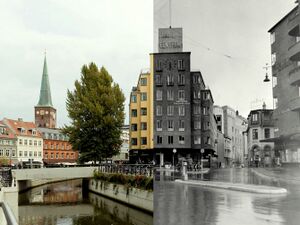
Aarhus Cathedral (Århus Domkirke) in the centre of Aarhus, is the longest and tallest church in Denmark at 93 m (305 ft) and 96 m (315 ft) in length and height respectively. Originally built as a Romanesque basilica in the 13th century, it was rebuilt and enlarged as a Gothic cathedral in the late 15th and early 16th centuries.[65] Even though the cathedral stood finished around 1300, it took more than a century to build; the associated cathedral school of Aarhus Katedralskole was already founded in 1195 and ranks as the 44th oldest school in the world.[66] Another important and historic landmark in the inner city, is the Church of Our Lady (Vor Frue Kirke) also from the 13th century in Romanesque and Gothic style. It is smaller and less impressive, but it was the first cathedral of Aarhus and founded on an even older church constructed in 1060; the oldest stone church in Scandinavia.[67][68][69][70] Langelandsgade Kaserne in National Romantic Style from 1889 is the oldest former military barracks left in the country; home to the university Department of Aesthetics and Communication since 1989. [71][72][73] Marselisborg Palace (Marselisborg Slot), designed by Hack Kampmann in Neoclassical and Art Nouveau styles, was donated by the city to Prince Christian and Princess Alexandrine as a wedding present in 1898.[74][75] The Aarhus Custom House (Toldkammeret) from 1898, is said to be Hack Kampmann's finest work.[76]
Tivoli Friheden (Tivoli Freedom) opened in 1903 and has since been the largest amusement park in the city and a tourist attraction. Aarhus Theatre from 1916 in the Art Nouveau style is the largest provincial theatre in Denmark.[77][78] The early buildings of Aarhus University, especially the main building completed in 1932, designed by Kay Fisker, Povl Stegmann and by C.F. Møller have gained an international reputation for their contribution to functionalist architecture.[79] The City Hall (Aarhus Rådhus) from 1941 with an iconic 60 m (200 ft) tower clad in marble, was designed by Arne Jacobsen and Erik Møller in a modern Functionalist style.
الثقافة
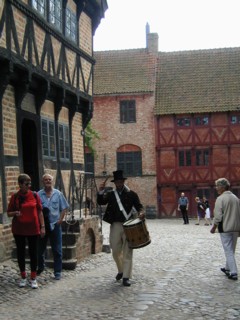
صور
- Aarhus in Pictures
العلاقات الدولية
Aarhus is home to 32 consulates:[80]
Aarhus practices twinning on the municipal level. For the twin towns, see twin towns of Aarhus Municipality.
المصادر
- ^ "Area by municipality / region" (in الدانمركية). Statistics Denmark. 8 أبريل 2016. Retrieved 8 أبريل 2016.
- ^ أ ب "Population by urban areas, age and sex" (in الدانمركية). Statistics Denmark. 26 يونيو 2016. Retrieved 26 يونيو 2016.
- ^ "Århus". The American Heritage Dictionary of the English Language (5th ed.). HarperCollins. Retrieved 16 أبريل 2019.
- ^ "Århus". Collins English Dictionary. HarperCollins. Retrieved 16 أبريل 2019.
- ^ "Aarhus" (US) and قالب:Cite Oxford Dictionaries
- ^ قالب:Cite Merriam-Webster
- ^ خطأ استشهاد: وسم
<ref>غير صحيح؛ لا نص تم توفيره للمراجع المسماةspelling - ^ "What is Business Region Aarhus". businessregionaarhus.dk. Retrieved 15 يناير 2019.
- ^ "Tal og statistik" [Figures and Statistics] (in الدانمركية). Byregion Østjylland. Archived from the original on 27 أبريل 2016. Retrieved 25 أبريل 2016.
- ^ "The World According to GaWC 2020". GaWC - Research Network. Globalization and World Cities. Retrieved 31 أغسطس 2020.
- ^ "Statistikbanken". www.statistikbanken.dk.
- ^ خطأ استشهاد: وسم
<ref>غير صحيح؛ لا نص تم توفيره للمراجع المسماةSalmonsen - ^ "Det omstridte bolle-å" (in الدانمركية). Aarhus portalen. Archived from the original on 8 أغسطس 2014. Retrieved 16 يوليو 2014.
- ^ "Byhistoriske hovedtræk – Byens grundlæggelse" (in الدانمركية). Aarhus Municipality. Archived from the original on 14 سبتمبر 2013. Retrieved 15 أغسطس 2014.
- ^ Hans Skov (2008). "Det ældste Århus – ca. 770–1200". UBAS Nordisk (in Danish). Bergen University. 5: 215–226. Retrieved 2 أبريل 2021.
{{cite journal}}: CS1 maint: unrecognized language (link) - ^ أ ب Grymer, Claus (1 يونيو 2005). "Vikingernes Aros mellem land og hav". Kristeligt Dagblad (in الدانمركية). Retrieved 16 يوليو 2014.
- ^ "Det Tidligste Århus" [The earliest Århus] (in الدانمركية). The Viking Museum. Archived from the original on 21 أبريل 2017. Retrieved 15 أغسطس 2014.
- ^ "Excavations – Nørrevold" (in الدانمركية). The Viking Museum (Moesgård Museum). Archived from the original on 19 أغسطس 2014. Retrieved 15 أغسطس 2014.
- ^ "Excavations" (in الدانمركية). The Viking Museum (Moesgård Museum). Archived from the original on 14 أغسطس 2014. Retrieved 15 أغسطس 2014.
- ^ "Tilbage til vikingetiden" [Back to the Viking Age] (in الدانمركية). Vikingemuseet (MOMU).
- ^ Kaiser, Jens (12 يونيو 2005). "Vikingernes Viby" (in الدانمركية). Jyllands-Posten Aarhus.
- ^ Google (18 ديسمبر 2014). "آرهوس" (Map). Google Maps. Google. Retrieved 18 ديسمبر 2014.
- ^ خطأ استشهاد: وسم
<ref>غير صحيح؛ لا نص تم توفيره للمراجع المسماةDMI-climate - ^ "FOLK1C: FOLKETAL DEN 1. I KVARTALET EFTER OMRÅDE, KØN, ALDER (5-ÅRS INTERVALLER), HERKOMST OG OPRINDELSESLAND". Statistics Denmark.
- ^ "Danmarks Købsteder: Århus" (in الدانمركية). Den digitale byport. Retrieved 8 ديسمبر 2014.
- ^ أ ب ت "Erhvervsstrukturen i Aarhus Kommune 2012" (PDF) (in الدانمركية). Aarhus Kommune. Archived from the original (PDF) on 2 أبريل 2017. Retrieved 8 ديسمبر 2014.
- ^ "Aarhus: Economy". The Times. Archived from the original on 6 أكتوبر 2014. Retrieved 23 يوليو 2014.
- ^ "Andel indpendlere" (in الدانمركية). Økonomi og Indenrigsministeriet. Archived from the original on 8 فبراير 2018. Retrieved 8 ديسمبر 2014.
- ^ "Interaktion og infrastruktur i Østjylland" (in الدانمركية). Miljøministeriet. Archived from the original on 25 يوليو 2015. Retrieved 8 ديسمبر 2014.
- ^ "Shoppere strømmer til byen" (in الدانمركية). Aarhus Stiftidende. Retrieved 11 ديسمبر 2014.
- ^ "Danmarkshistorien.dk". Gyldendal. Retrieved 9 ديسمبر 2014.
- ^ "Strøget". Strøgforeningen. Archived from the original on 15 يناير 2015. Retrieved 23 نوفمبر 2014.
- ^ "De 10 største virksomheder i Aarhus". jyllandsposten.dk (in الدانمركية). Jyllandsposten. Retrieved 9 ديسمبر 2014.
- ^ "The tightest wind cluster in the world" (in الدانمركية). Windpower.org. Archived from the original on 9 مايو 2016. Retrieved 20 أغسطس 2014.
- ^ "Biotekselskaber i Danmark ultimo 2007" (PDF). Dansk biotek. Archived from the original (PDF) on 29 نوفمبر 2015. Retrieved 9 ديسمبر 2014.
- ^ "Vestas gains impressive lead as top wind-turbine manufacturer". Windpower Engineering & Development.
- ^ خطأ استشهاد: وسم
<ref>غير صحيح؛ لا نص تم توفيره للمراجع المسماةdsd - ^ "Find Vestas". Vestas Windsystems. Retrieved 9 ديسمبر 2014.
- ^ Ravn, Morten (7 فبراير 2017). "Aarhus-firma scorer milliard kontrakt med USAs forsvar". stiften.dk.
- ^ "Top Companies in Aarhus". Aarhus Stifstidende. Retrieved 9 ديسمبر 2014.
- ^ "Aarhus er en magnet for firmaer". Jyllandsposten. Retrieved 9 ديسمبر 2014.
- ^ "About Port of Aarhus". Aarhus Havn. Archived from the original on 24 يوليو 2014. Retrieved 16 يوليو 2014.
- ^ أ ب Signe Ferslev Pedersen (21 يوليو 2014). "Mærsk-arving vil kapre mere gods til Aarhus". Berlingske Tidende (in الدانمركية). Retrieved 23 يوليو 2014.
- ^ "Cargo statistics". Aarhus Havn. Archived from the original on 23 يونيو 2014. Retrieved 21 يوليو 2014.
- ^ "Aarsrapport 2013" (PDF) (in الدانمركية). Aarhus Havn. Retrieved 9 ديسمبر 2014.
- ^ "Denmark's top attractions". Visit Denmark. Archived from the original on 20 أغسطس 2014. Retrieved 29 يوليو 2014.
- ^ "Festivals energize Aarhus' tourism industry". Jutlandstation.dk. 13 يونيو 2014. Archived from the original on 29 يوليو 2014. Retrieved 29 يوليو 2014.
- ^ "Aarhus – a city of shopping" (PDF). Business Aarhus. Archived from the original (PDF) on 20 يوليو 2014. Retrieved 29 يوليو 2014.
- ^ "Cruise ships terminal". Aarhus Havn. Archived from the original on 6 أغسطس 2014. Retrieved 29 يوليو 2014.
- ^ أ ب "Aarhus som kulturel city destination" (PDF). kulturturisme.dk. Retrieved 23 نوفمبر 2014.
- ^ "Tourist Information". VisitAarhus. Archived from the original on 18 أغسطس 2014. Retrieved 5 أغسطس 2014.
- ^ "Om VisitAarhus" (in الدانمركية). VisitAarhus. Archived from the original on 28 يوليو 2014. Retrieved 5 أغسطس 2014.
- ^ "Vedtægter for VisitAarhus" (PDF) (in الدانمركية). Region Midtjylland. 18 يناير 2005. Retrieved 5 أغسطس 2014.[dead link]
- ^ "INCUBA Science Park – Historie" (in الدانمركية). INCUBA Science Park. Archived from the original on 15 أغسطس 2016. Retrieved 1 أكتوبر 2016.
- ^ "Fødevareforskningen får kontor i Agro Food Park" (in الدانمركية). Aarhus University. Archived from the original on 3 نوفمبر 2016. Retrieved 1 أكتوبر 2016.
- ^ أ ب "Fakta om Agro Food Park" (in الدانمركية). Agro Food Park. Archived from the original on 2 أكتوبر 2016. Retrieved 20 سبتمبر 2016.
- ^ "Arkitekturklyngen i Århus" (PDF) (in الدانمركية). Center for Strategisk Byforskning. Archived (PDF) from the original on 20 ديسمبر 2016. Retrieved 1 أكتوبر 2016.
- ^ "AAØ Anbefaler Arkitektklyngen i Aarhus" (in الدانمركية). Danish Association of Architects. Archived from the original on 17 أكتوبر 2017. Retrieved 1 أكتوبر 2016.
- ^ "Arkitekterhvervets visioner for en ny arkitektskole i Aarhus" (in الدانمركية). Danish Association of Architects. Archived from the original on 17 أكتوبر 2017. Retrieved 1 أكتوبر 2016.
- ^ "Gode muligheder for at bevare Jyllands svar på Christiania". Århus Stiftstidende (in الدانمركية). Archived from the original on 9 أكتوبر 2016. Retrieved 1 أكتوبر 2016.
- ^ "Arkitektur og byggeskik i byen" (in الدانمركية). Aarhus Kommune. Archived from the original on 14 سبتمبر 2013. Retrieved 14 ديسمبر 2014.
- ^ "Kulturhistorisk redegørelse 2013" (in الدانمركية). Aarhus Kommune. Retrieved 14 ديسمبر 2014.
- ^ Olsen 2000, p. 124.
- ^ "Fejl". ledelsesinformation.aarhuskommune.dk. Archived from the original on 9 نوفمبر 2020. Retrieved 24 مايو 2021.
- ^ "Kirkebygningen" (in الدانمركية). Aarhus Domkirke. Retrieved 17 يوليو 2014.
- ^ "Historien" (in الدانمركية). Aarhus Katedralskole. Archived from the original on 11 أكتوبر 2014. Retrieved 22 يوليو 2014.
- ^ "Kryptkirken" (in الدانمركية). Vor Frue Krirke i Aarhus. Retrieved 17 يوليو 2014.
- ^ "Romansk 1050–1250" (in الدانمركية). Aarhus Kommune. Archived from the original on 4 مارس 2016. Retrieved 28 يوليو 2014.
- ^ "Vor Frue Kirke og Kloster" (in الدانمركية). Aarhus Universitet. Retrieved 17 يوليو 2014.
- ^ "Vor Frue Kirke" (in الدانمركية). AarhusWiki. Retrieved 17 يوليو 2014.
- ^ "Langelandsgades Kaserne (Artillerikasernen), Århus" (in الدانمركية). ArkArk. Archived from the original on 20 ديسمبر 2014. Retrieved 20 ديسمبر 2014.. Architectural and historical information with images.
- ^ "Kasernen" (in الدانمركية). Department of Arts, Aarhus University. 18 ديسمبر 2014. Retrieved 20 ديسمبر 2014.
- ^ P. E. Niemann (1981): Feltartilleriet i Aarhus 1881–1969 Zac, ISBN 87-7348-047-9 (in دنماركية)
- ^ "Marselisborg Palace". Kongehuset.dk. Archived from the original on 7 يوليو 2015. Retrieved 18 يوليو 2014.
- ^ Tarbensen, Kenn. "Marselisborg Slot" (in الدانمركية). historie-online.dk. Archived from the original on 24 سبتمبر 2015. Retrieved 18 يوليو 2014.
- ^ Egeberg, Kasper. "Toldkammeret (the Custom House)". DAC. Archived from the original on 25 يوليو 2014. Retrieved 18 يوليو 2014.
- ^ "Aarhus Teater" (in الدانمركية). Gyldendal. Retrieved 18 يوليو 2014.
- ^ "Aarhus Teater får millionstøtte". Berlingske Tidende (in الدانمركية). 12 أبريل 2011. Retrieved 18 يوليو 2014.
- ^ "Aarhus Universitet" (in الدانمركية). Gyldendal. Retrieved 18 يوليو 2014.
- ^ "Foreign consulates in Denmark" (in الدانمركية). Danmarks-ambassade.com. Retrieved 15 نوفمبر 2015.
وصلات خارجية
56°09′26″N 10°12′39″E / 56.1572°N 10.2107°E
مواقع رسمية
- Århus Kommune, official city portal
مواقع تجارية
خطأ استشهاد: وسوم <ref> موجودة لمجموعة اسمها "note"، ولكن لم يتم العثور على وسم <references group="note"/>
- CS1 الدانمركية-language sources (da)
- Articles with dead external links from September 2019
- Articles with دنماركية-language sources (da)
- Pages using gadget WikiMiniAtlas
- Short description is different from Wikidata
- صفحات بالمعرفة فيها قوالب حماية خاطئة
- صفحات شبه محمية للأبد في المعرفة
- EngvarB from October 2017
- مقالات جيدة
- Use dmy dates from November 2019
- Official website different in Wikidata and Wikipedia
- مقالات فيها عبارات متقادمة منذ يناير 2021
- جميع المقالات التي فيها عبارات متقادمة
- Articles containing دنماركية-language text
- Articles with hatnote templates targeting a nonexistent page
- Coordinates on Wikidata
- Aarhus
- Cities and towns in the Central Denmark Region
- Cities and towns in Aarhus Municipality
- Municipal seats of the Central Denmark Region
- مقار بلديات الدنمارك
- موانئ الدنمارك
- أماكن مأهولة في عصر الڤايكنگ
- آرهوس
- Municipal seats of Region Midtjylland
- مدن الدنمارك
- Articles including recorded pronunciations (Danish)
